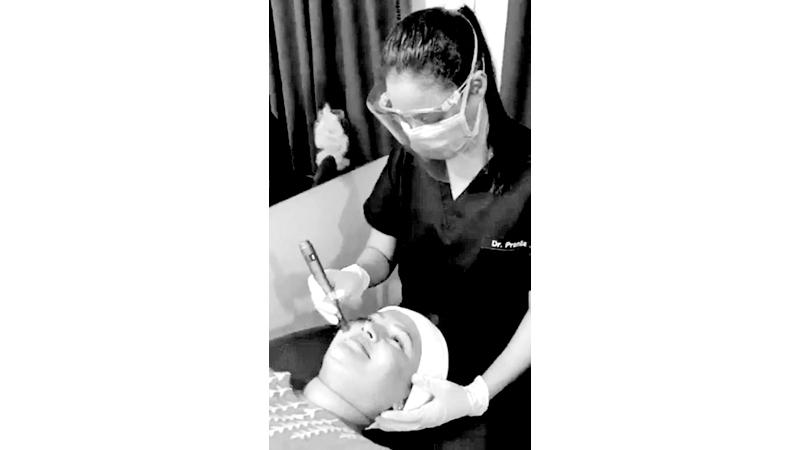
Skin bleaching is a cosmetic practice that aims to lighten someone’s skin. Some use it to lighten specific areas or dark spots, while others may want to lighten their overall skin tone.
Many products that claim to lighten skin tone are not safe. According to the International Journal of Dermatology, skin bleaching poses a serious public health threat because many contain mercury, which is a toxic heavy metal.
Hydroquinone and niacinamide are safer options. However, there is no guarantee they will lighten the complexion evenly.
Researchers connect racism to the trend for skin bleaching. When people believe that only lighter skin is attractive, they may become unhappy with their own appearance. This can affect mental health.
Skin bleaching is the practice of trying to lighten the skin. It has existed for hundreds of years.
Some use skin lightening to reduce the appearance of specific areas of hyperpigmentation. This is when a specific area of the skin darkens in response to an injury or medical condition, such as acne, sun damage and pregnancy, which can cause melasma.
Dermatologists often provide advice and safe treatment options for lightening smaller areas of the skin.
 Cosmetic Physician
Dr. Pramila Ranasinghe
|
However, the term “skin bleaching” usually refers to overall skin lightening, which is not something dermatologists support. This practice aims to lighten the whole complexion, changing a person’s skin tone.
Skin bleaching is very common worldwide. A 2018 meta-analysis and meta-regression study that included 68 studies and 67,665 participants found that 27.7 percent had tried to bleach their skin.
A report by the World Health Organization (WHO) estimates that, by 2024, the skin bleaching industry will be worth $31.2 billion
Hydroquinone
Hydroquinone is a depigmentation agent that is present in many skin bleaching products. A person can buy a 2 percent solution over the counter or seek a prescription for a stronger 4 percent solution. Results usually appear within 3–6 months after applying hydroquinone one to two times per day.
Hydroquinone has many potential adverse effects. It can increase the skin’s sensitivity to the sun, so it is important to use sunscreen. Some other potential side effects include blue-gray skin discoloration, skin irritation and redness, burning, damage to the skin, skin dryness and false elevation of blood glucose on a blood glucose test that uses blood from capillaries.
The WHO considers hydroquinone to be a “hazardous chemical.”
Mercury
Mercury is a toxic metal that harms humans and the environment. Despite this, it is in many skin-lightening products, including soaps, creams and other cosmetics. It inhibits the formation of melanin, resulting in a lighter skin tone.
People who use mercury-containing products on the skin may develop skin rashes, skin discoloration, reduced resistance to skin infections, anxiety, depression, psychosis, peripheral and neuropathy and kidney damage.
With enough exposure, mercury can cause death.
Mercury may appear on product labels under the names of mercury, Hg, mercury oxide, mercuric iodide, ethyl mercury, mercurous chloride and phenyl mercuric salts.
However, not all manufacturers list their ingredients transparently, making it hard to know if skin lightening products contain mercury. Instructions to avoid contact with metal jewellery can be a warning sign, as mercury bonds to some precious metals, such as gold.
Numerous countries have banned mercury for cosmetic use, but not all. Even in places where it is illegal, it is possible to buy products that contain it online.
When people wash mercury-containing products off their skin, it eventually ends up in the ocean, where it can enter the food chain and contaminate fish. Eating these fish can also harm humans, as well as other animals.
Other ingredients
A 2018 review found preliminary evidence to support the use of some other ingredients for treating hyperpigmentation but emphasises a need for further research. These ingredients include aloesin, azelaic acid, turmeric, arbutin, green tea, ellagic acid and koji berry.
Results of skin bleaching
The results of skin lightening treatment, whether for specific areas or the whole complexion, vary greatly.
Safer ingredients, such as niacinamide and vitamin C, may modestly reduce hyperpigmentation. However, the extent of the reduction depends on the individual case. Attempts to change the entire skin tone are much riskier. It can result in patchy, uneven pigmentation or in hyperpigmentation, making the skin darker in places.
For example, hydroquinone can cause ochronosis, which is blue or black discoloration. Ochronosis is more common when a person uses hydroquinone at high doses.
Is skin bleaching ever safe?
Treating areas of hyperpigmentation can be safe if a person uses dermatologist-approved methods and avoids harmful substances.
However, attempts to bleach the entire skin are always risky, even if someone uses safer methods. It may cause an uneven skin tone, irritation, rashes, or eczema and discoloration.
Globally, the biggest risk of skin bleaching by far comes from mercury.
Skin bleaching is a common cosmetic practice worldwide. Some use it to lighten specific areas of hyperpigmentation. However, many use skin bleaching products to lighten their complexion overall. There is no safe or reliable way to lighten someone’s skin tone. Products or DIY recipes that claim to do so carry numerous risks. Even legal and over-the-counter options, such as hydroquinone creams, can sometimes lead to permanent discoloration.
Cosmetic Physician Dr. Pramila Ranasinghe is the driving force behind the operation.
